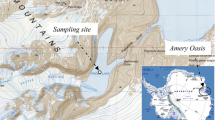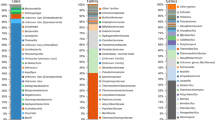Abstract
New methods based on PCR amplification of 16S rRNA genes from DNA samples extracted directly from the environment allow the description of microbial diversity in natural ecosystems without the need for cultivation. We have applied this technique to an extreme environment presumed to have very low diversity: the crystallizer ponds of a marine saltern with salinity over NaCl saturation. The molecular methodology has shown that indeed very low diversity can be found here. Prokaryotes belonging to the Bacteria domain are a minor component and only members of a closely related cluster of sequences were found, all relatives of the α-Proteobacteria (ca. 83% to Rhodopseudomonas marina). Halophilic Archaea were as expected the largest component of biomass in this environment. All the clones sequenced corresponded again to a highly homologous cluster (probably members of the same genus). However, all the sequences diverged considerably from the ones of the described genera of halophilic Archaea, in fact the data are consistent with the idea that the 16S rRNA genes directly amplified from the saltern correspond to members of an undescribed genus. This is remarkable since many collection strains sequenced come specifically from this saltern. Furthermore, 16S rDNA obtained from archaeal cultures isolated from the same sample had no homology to the sequences obtained by PCR amplification, instead they appear to be members of the well known genus Haloarcula. However, this concurs with the findings of other authors who obtained different organisms by culture from those detected by the sequences retrieved directly by PCR. A possible explanation is that culturability, in standard media, is the exception rather than the rule. To study the biodiversity gradient present along the salinity gradient found in a multi-pond solar saltern we have also applied a novel molecular strategy. This method is based on the restriction digestion of a population of 16S rDNA sequences directly amplified from an environmental sample. Digested fragments separated by polyacrylamide gel electrophoresis generate characteristic profile data for estimation of diversity and overall similarities between the organisms of different environments. The methodology has been applied to a set of five ponds covering the salinity gradient from about twice that of seawater (6.4%) to NaCI precipitation (30.8%). Bacterial (eubacterial) diversity estimated from the complexity of the banding pattern obtained by restriction of the amplicons from the different ponds decreased with increasing salinity while for Archaea (archaebacteria) the reverse was true i.e. the higher the salinity the higher the number of bands. The similarities in taxonomic composition of the prokaryotic populations present in those ponds were evaluated from the number of restriction bands shared by the different samples. The relationships found among the different environments were independent of the enzyme used for digestion and were consistent with previous descriptions obtained by the study of isolates from the different environments. This technique appears to be promising as a rapid method for microbial biodiversity fingerprinting useful to compare several environments and detect major shifts in species composition of the microbial population.
Similar content being viewed by others
References
Amaan, R. I., W. Ludwig & K-H. Schleifer, 1995. Phylogenetic identification and in situ detection of individual microbial cells without cultivation. Microbiol. Rev. 59: 143–169.
Avaniss-Aghajani, E., K. Jones, D. Chapman & C. Brunk, 1994. A molecular technique for identification of bacteria using small subunit ribosomal RNA sequences. BioTechniques, 17: 144–149.
Barbe, A., J. O. Grimalt, J. J. Pueyo & J. Albaiges, 1990. Characterization of model evaporitic environments through the study of lipid components. Org. Geochem. 8: 293–297.
Barns, S. M., R. E. Fundyga, M. W. Jeffries & N. R. Pace. 1994. Remarkable archaeal diversity detected in a Yellowstone National Park hot spring environment. Proc. Natl. Acad. Sci. USA. 91: 1609–1613.
Beaucage, S. L. & M. H. Caruthers, 1981. Dideoxynucleotide phosphoramidites — a new class of key intermediates for deoxypolynucleotide synthesis. Tetrahedrom Lett. 22: 1859–1862.
Benlloch, S., A. J. Martínez-Murcia & F. Rodríguez-Valera, 1996. Bacterial and archaeal diversity as shown by partial sequencing of 16S rRNA genes directly amplified from a hypersaline environment System. Applied Microbiol. (in press).
Brosius, J. P., T. J. Dull, D. D. Sleeter & H. F. Noyer, 1981. Gene organization and primary structure of a ribosomal RNA operon from E. coli. J. Mol. Biol. 148: 107–127.
DeLong, E. F., K. Y. Wu, B. B. Prézelin & R. V. M. Jovine; 1994. High abundance of Archaea in Antarctic marine picoplankton. Nature 371: 695–697.
DeLong, E. F., 1992. Archaea in coastal marine environments. Proc. Natl. Acad. Sci. USA. 89: 5685–5689.
Fuhrman, J. A., K. McCallum & A. A. Davis, 1992. Novel major archaebacterial group from marine plankton. Nature 356: 148–149.
Fuhrman, J. A., K. McCallum & A. A. Davis, 1993. Phylogenetic diversity of subsurface marine microbial communities from the Atlantic and Pacific Oceans. Appl. Envir. Microbiol. 59: 1294–1302.
Giovannoni, S. J., T. B. Britschgi, C. L. Moyer & K. G. Fieldt, 1990a. Genetic diversity in Sargasso Sea bacterioplankton. Nature 345: 60–63.
Giovannoni, S. J., E. F. DeLong, T. M. Schmidt & N. R. Pace, 1990b. Tangential flow filtration and preliminary phylogenetic analysis of marine picoplankton. Appl. Envir. Microbiol. 56: 2572–2575.
Grant, W. D. & H. N. M. Ross, 1986. The ecology and taxonomy of halobacteria. FEMS Microbiol. Rev. 39: 9–15.
Höfle, M. G., 1992. Bacterioplankton community structure and dynamics after large-scale release of nonindigenous bacteria as revealed by low-molecular-weight-RNA analysis. Appl. Envir. Microbiol. 58: 3387–3394.
Javor, B. J., 1983a. Planktonic standing crop and nutrients in a saltern ecosystem. Limnol. Oceanogr. 28: 153–159.
Javor, B. J., 1983b. Nutrients and ecology of the Western Salt and Exportadora de Sal saltem brines. 6th International Symposium on Salt. Vol. 1. Salt Institute.
Kamekura, M. & Y. Seno, 1993. Partial sequence of the gene for a serine protease from a halophilic archaeum Haloferax mediterranei R4, and nucleotide sequences of 16S rRNA encoding genes from several halophilic archaea. Experientia 49: 503–513.
Kushner, D. J. & M. Kamekura, 1988. Physiology of halophilic eubacteria. In: Rodriguez-Vales, F. (ed.), Halophilic Bacteria, Volume I. CRC Press, Inc. Boca Raton, Florida: 109–138.
Lane, D. J., B. Pace, G. J. Olsen, D. A. Stahl, M. L. Sogin & N. R. Pace, 1985. Rapid determination of 16S rRNA sequences for phylogenetic analysis. Proc. Natl. Acad. Sci. USA. 82: 6955–6959.
Larsen, H. & W. D. Grant, 1989. Genus I: Halobacterium. Elazari-Volcani 1957, 207AL, p. 2219. In J. T. Staley, M. P. Bryant, N. Pfennig & J. G. Holt (eds), Bergey's Manual of Systematic Bacteriology, Vol. 3. The Williams & Wilkins Co., Baltimore.
Liesack, W. & E. Stackebrandt, 1992. Occurrence of novel groups of the Domain Bacteria as revealed by analysis of genetic material isolated from an Australian Terrestrial Environment. J. Bacterial. 174: 5072–5078.
Maniatis, T., E. F. Fritsch & J. Sambrook, 1982. Molecular cloning: a laboratory manual. Cold Spring Harbor Laboratory Press, Cold Spring Harbor, N.Y.
Mankin, A. S., V. K. Kagramanova, N. L. Teterina, P. M. Rubtsov, E. N. Belova, A. M. Kopylov, L. A. Baratova & A. A. Gogdanov, 1985. The nucleotide sequence of the gene coding for the 165 rRNA from the archaebacterium Halobacterium halobium. Gene 37: 181–189.
Marchuk, D., M. Drumm, A. Saulino & F. S. Collins, 1990. Construction of T -vectors, a rapid and general system for direct cloning of unmodified PCR products. Nucl. Acids. Res. 19: 1154.
Martinez-Murcia, A. J., S. Benlloch & M. D. Collins, 1992. Phylogenetic interrelationships of members of the genera Aeromonas and Plesiomonas as determined by 165 rDNA sequencing: lack of congruence with results of DNA-DNA hybridization. Int. J. Syst. Bact. 42: 412–421.
Martínez-Murcia, A. J., 1993. Doctoral Thesis. Department of Microbiology, University of Reading, Reading, U.K.
Martínez-Murcia, A. J. & F. Rodriguez-Valera, 1994. The use of arbitrarily primed PCR (APPCR) to develop taxa specific DNA probes of known sequence. FEMS Microbiol. Lett. 124: 265–270.
Martínez-Murcia, A. J., S. G. Acinas & F. Rodríguez-Valera, 1996. Evaluation of prokaryotic diversity by restrictase digestion of 16S rDNA directly amplified from hypersaline environments. FEMS Microbiol. Ecol. (in press).
Mellado Duran, M. E., 1994. Bacerias halofilas moderadas: filogenia y construccion de vectores de clonacion. PhD Thesis, University of Sevilla.
Moyer, C. L., F. C. Dobbs & D. M. Karl, 1994. Estimation of diversity and community structure through restriction fragment length polymorphism distribution analysis of bacterial 165 rRNA genes from a microbial mat at an active, hydrothermal vent system, Loihi Seamount, Hawaii. Appl. Envir. Microbiol. 60: 871–879.
Muyzer, G., E. C. De Waal & A. G. Uitterlinden, 1993. Profiling of complex microbial populations by denaturing gradient gel electrophoresis analysis of Polymerase Chain Reaction-Amplified genes coding for 16S rRNA. Appl. Envir. Microbiol. 59: 695–700.
Oren, A., 1990. Estimation of the contribution of halobacteria to the bacterial biomass and activity in solar saltems by the use of bile salts. FEMS Microbiol. Ecol. 73: 41–48.
Pace, N. R., D. A. Stahl, D. J. Lane & G. J. Olsen, 1986. The analysis of natural microbial populations by ribosomal RNA sequences. Adv. Microb. Ecol. 9: 1–55.
Ralph, D., M. McClelland, J. Welsh, G. Baranton & P. Perolat, 1993. Leptospira species categorized by arbitrarily primed polymerase chain reaction (PCR) and by mapped restriction polymorphisms in PCR-amplified rRNA genes. J. Bacterial. 175: 973–981.
Reysenbach, A-L., G. S. Wickham & N. R. Pace, 1994. Phylogenetic analysis of the hyperthermophilic pink filament community in Octopus Spring, Yellowstone National Park. Appl. Envir. Microbiol. 60: 2113–2119.
Rodríguez-Valera, F., F. Ruiz-Berraquero & A. Ramos-Cormenzana, 1981. Characteristics of the heterotrophic bacterial populations in hypersaline environments of different salt concentrations. Microb. Ecol. 7: 235–243.
Rodriguez-Valera, R, 1986. The ecology and taxonomy of aerobic chemoorganotrophic halophilic eubacteria. FEMS Microbiol. Rev. 39: 17–22.
Rodríguez-Valera, F., A. Ventosa, G. Juez & J. F. Imhoff, 1985. Variation of environmental features and microbial populations with salt concentrations in a multi-pond saltem. Microb. Ecol. 11: 107–115.
Sanger, F., S. Nicklen & A. R. Coulson, 1977. DNA sequencing with chain-terminating inhibitors. Proc. Natl. Acad. Sci. USA. 74: 5463–5467.
Schmidt, T. M., E. F. DeLong & N. R. Pace, 1991. Analysis of a marine picoplankton community by 165 rRNA gene cloning and sequencing. J. Bacterial. 173: 4371–4378.
Stackebrandt, E., W. Liesack & B. M. Goebel, 1993. Bacterial diversity in a soil sample from a subtropical Australian environment as determined by 165 rDNA analysis. The FASEB J. 7: 232–236.
Torsvik, V., S. Käre, R. Sørarheim & J. Goksoyr, 1990. Comparison of phenotypic diversity and DNA heterogeneity in a population of soil bacteria. Appl. Envir. Microbiol. 56: 776–781.
Walsby, A. E., 1980. A square bacterium. Nature 283: 69.
Ward, D. M., R. Weller & M. M. Bateson, 1990. 165 rRNA sequences reveal numerous uncultured microorganisms in a natural community. Nature 345: 63–65.
Weller, R., J. W. Weller & D. M. Ward, 1991. 165 rRNA sequences of uncultivated hot spring cyanobacterial mat inhabitants retrieved as randomly primed cDNA. Appl. Envir. Microbiol. 57: 1146–1151.
Author information
Authors and Affiliations
Additional information
Author for correspondence
Rights and permissions
About this article
Cite this article
Benlloch, S., Acinas, S.G., Martínez-Murcia, A.J. et al. Description of prokaryotic biodiversity along the salinity gradient of a multipond solar saltern by direct PCR amplification of 16S rDNA. Hydrobiologia 329, 19–31 (1996). https://doi.org/10.1007/BF00034544
Issue Date:
DOI: https://doi.org/10.1007/BF00034544




